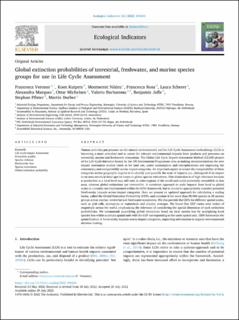| dc.contributor.author | Verones, Francesca | |
| dc.contributor.author | Kuipers, Koen Jacobus Josefus | |
| dc.contributor.author | Núñez, Montse | |
| dc.contributor.author | Rosa, Francesca | |
| dc.contributor.author | Scherer, Laura | |
| dc.contributor.author | Marques, Alexandra | |
| dc.contributor.author | Michelsen, Ottar | |
| dc.contributor.author | Barbarossa, Valerio | |
| dc.contributor.author | Jaffe, Benjamin | |
| dc.contributor.author | Pfister, Stephan | |
| dc.contributor.author | Dorber, Martin | |
| dc.date.accessioned | 2022-11-29T08:47:33Z | |
| dc.date.available | 2022-11-29T08:47:33Z | |
| dc.date.created | 2022-07-30T09:00:36Z | |
| dc.date.issued | 2022 | |
| dc.identifier.issn | 1470-160X | |
| dc.identifier.uri | https://hdl.handle.net/11250/3034661 | |
| dc.description.abstract | Human activities put pressure on the natural environmental and the Life Cycle Assessment methodology (LCA) is becoming a more prevalent tool to assess the relevant environmental impacts from products and processes on terrestrial, marine and freshwater ecosystems. The Global Life Cycle Impact Assessment Method (GLAM) project of the Life Cycle Initiative hosted by the UN Environment Programme aims at making recommendations for new impact assessment models (such as for land use, water consumption and eutrophication) and improving the consistency and comparability across impact categories. An important aspect to ensure the comparability of these categories across geographic regions is to identify and quantify the scale of impacts, i.e., distinguish if an impact to an area results in local species losses or global species extinctions. This distinction is of high relevance because a species lost at a local level may still exist in other regions of the world and could potentially reestablish in that area, whereas global extinctions are irreversible. A consistent approach to scale impacts from local to global scales is currently not implemented within the LCIA framework, but is crucial to appropriately consider potential biodiversity impacts across impact categories. Here we present an updated approach for calculating a scaling factor, called the Global Extinction Probability (GEP), and calculate it for more than 98 000 species in 20 species groups across marine, terrestrial and freshwater ecosystems. We also provide the GEPs for different spatial scales, such as grid cells, ecoregions or watersheds and country averages. We found that GEP varies over orders of magnitude across the world, emphasizing the relevance of considering the spatial dimension of such extinction probabilities. We recommend quantifying global extinctions based on local species loss by multiplying local species loss within a certain spatial unit with the GEP corresponding to the same spatial unit. GEPs harmonize the quantification of biodiversity impacts across impact categories, improving information to support environmental decision-making. | en_US |
| dc.language.iso | eng | en_US |
| dc.publisher | Elsevier | en_US |
| dc.rights | Navngivelse 4.0 Internasjonal | * |
| dc.rights.uri | http://creativecommons.org/licenses/by/4.0/deed.no | * |
| dc.title | Global extinction probabilities of terrestrial, freshwater, and marine species groups for use in Life Cycle Assessment | en_US |
| dc.title.alternative | Global extinction probabilities of terrestrial, freshwater, and marine species groups for use in Life Cycle Assessment | en_US |
| dc.type | Peer reviewed | en_US |
| dc.type | Journal article | en_US |
| dc.description.version | publishedVersion | en_US |
| dc.source.volume | 142 | en_US |
| dc.source.journal | Ecological Indicators | en_US |
| dc.identifier.doi | 10.1016/j.ecolind.2022.109204 | |
| dc.identifier.cristin | 2040115 | |
| cristin.ispublished | true | |
| cristin.fulltext | original | |
| cristin.qualitycode | 1 | |

